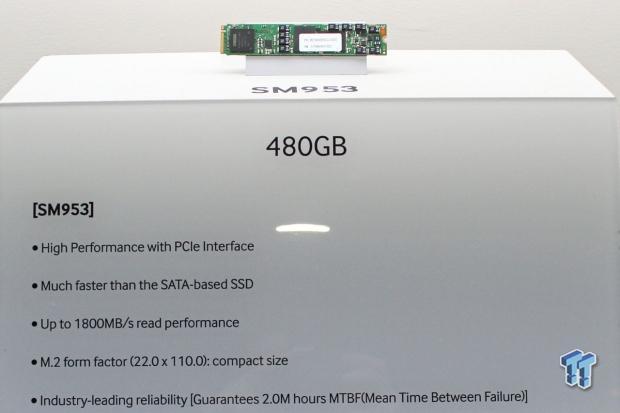Samsung is on a roll with V-NAND and 3bit MLC datacenter products making a huge splash at the 2014 Samsung Global SSD Summit in Seoul. The SM953, the world's first M.2 SSD designed for the datacenter, was yet another exciting Samsung-exclusive product on display in the product showcase.
The chains of legacy HDD form factors have been binding SSDs into large bulky cases that are not required for today's dense NAND. M.2 provides a new standardized form factor that limits the device to the size of the NAND, controller, PCB, and other components. This will allow for denser deployments and enable even smaller blade and microserver designs. Storage and performance density are paramount in the datacenter and SSDs provide the ultimate in both respects. It is encouraging to see these new designs finally making their way into the datacenter.

Other than the 1,800 MB /s sequential read performance, there is precious little information publicly available at this point. We do know that the SM953 comes in one capacity of 480GB. M.2 also has standardized designs that are longer, which will allow for even more NAND per device. The inclusion of V-NAND, with its enhanced density, will also provide much more capacity in these 'gumstick' devices. There is no mention of the NAND employed on the SM953.

A few interesting details were outlined briefly during the presentation. The first is that the SM953 will deliver incredible power efficiency. Power is always a big concern and can lead to excessive heat generation. Active power is rated for 6W, whereas the competition is rated for 10-25W per device. Compatibility with NVMe v1.1 assures that the SM953 provides the latest in power optimizations from the NVMe spec. NVMe revision 1.1 includes enhanced autonomous sleep state functionality for NVMe devices, which will enable lower idle power draw much like DEVSLP. NVMe provides even more streamlined efficiency by allowing the device to automatically transition into lower sleep states without host initiation.
The use of NVMe is also important; it offers a more efficient interface that leaves the baggage of AHCI behind. We provide in-depth coverage of the NVMe specification in our Defining NVMe - Hands-on testing with the Intel P3700 article. The SM953 is certified compliant with NVMe spec 1.1 by the UNH-IOL lab. The slide also indicates that there will be both M.2 and 2.5" versions available.

One of the immediate observations is the relatively few NAND packages present on the device, likely due to the inclusion of the power capacitors. These 11 power capacitors provide enough power to flush all data to the NAND in the event of a power loss situation. This is a critical requirement in enterprise environments, and requires firmware optimizations that manage power-loss-protection functionality.

The controller model hasn't been officially released, but we note that its S4LN058X01-8030 part number only varies by one number from the S4LN053X01-8030 controller found on the XP941 Chris reviewed here. We speculate this new controller to be a variant of the XP941 tri-core UAX controller. There is also the notable listing of "UBX" on the bottom of the controller, possibly indicating a second generation of the UAX controller.
It's exciting to see M.2 designs making the way into the datacenter. Future backplanes can be integrated tightly into the server via PCIe switches, providing the ultimate in density. The thin design not only allows for shrinking the server, but also for more efficient cooling.
